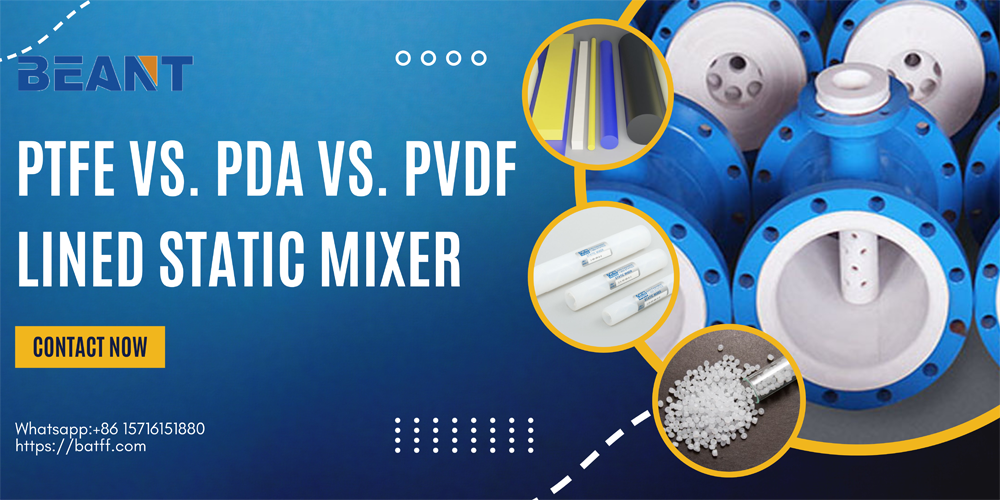
In various industrial applications, static mixers are indispensable tools for blending fluids and gases efficiently. They offer a streamlined solution for mixing processes, eliminating the need for moving parts and external power sources. Among the many types of lined static mixers, PTFE, PDA, and PVDF are the most commonly used due to their unique properties and benefits. This article delves into the specifics of each type, helping you determine which lined static mixer is best suited for your specific needs. We will explore the properties, applications, and advantages of PTFE, PDA, and PVDF lined static mixers, providing a comprehensive comparison to guide your decision-making process.
PTFE, or Polytetrafluoroethylene, is a high-performance polymer known for its exceptional chemical resistance and thermal stability. These properties make PTFE an ideal lining material for static mixers used in highly corrosive and high-temperature environments.
1.Chemical Resistance: PTFE is virtually impervious to most chemicals, making it suitable for applications involving aggressive acids, bases, and solvents.
2.Temperature Stability: PTFE can withstand a wide range of temperatures, from -200°C to 260°C, without losing its structural integrity.
3.Low Friction Coefficient: PTFE has a very low friction coefficient, which helps in minimizing pressure drop across the mixer and ensures smooth flow.
4.Non-stick Surface: The non-stick nature of PTFE prevents material build-up, reducing the risk of blockages and making maintenance easier.
1.Chemical Processing: PTFE lined static mixers are extensively used in the chemical industry for mixing highly corrosive chemicals. They ensure uniform blending while withstanding the harsh chemical environment.
2.Pharmaceuticals: In the pharmaceutical industry, PTFE lined mixers are preferred for their inert nature, ensuring that the mixer does not react with or contaminate the pharmaceutical compounds.
3.Food and Beverage: PTFE’s non-reactive and non-stick properties make it suitable for mixing food-grade materials, ensuring hygiene and ease of cleaning.
4.Water Treatment: In water treatment plants, PTFE lined static mixers are used to mix chemicals for water purification, benefiting from PTFE’s resistance to chemical corrosion.
1.Durability: PTFE lined static mixers offer long-lasting performance even in the most demanding environments.
2.Versatility: The broad chemical resistance and temperature stability make PTFE suitable for a wide range of applications.
3.Ease of Maintenance: The non-stick properties reduce the frequency of cleaning and maintenance, saving operational costs and downtime.
PTFE lined static mixers are a robust solution for industries requiring reliable and efficient mixing in chemically aggressive and high-temperature conditions. Their superior properties make them a preferred choice for many critical applications.
Polyamide (PDA) lined static mixers are another popular choice for various industrial applications. PDA is known for its excellent mechanical strength, wear resistance, and good chemical resistance. These properties make PDA lined static mixers suitable for applications involving abrasive fluids and less aggressive chemicals.
1.Mechanical Strength: PDA offers high tensile strength and impact resistance, ensuring durability and long service life under demanding conditions.
2.Wear Resistance: PDA’s excellent wear resistance makes it ideal for handling abrasive materials, reducing the risk of damage and prolonging the mixer’s lifespan.
3.Chemical Resistance: While not as chemically resistant as PTFE, PDA can still withstand many common industrial chemicals, including oils, greases, and fuels.
4.Thermal Stability: PDA can operate effectively in moderate temperature ranges, typically up to 120°C, without significant degradation.
1.Oil and Gas: PDA lined static mixers are widely used in the oil and gas industry for mixing drilling fluids and other hydrocarbons, benefiting from their mechanical strength and wear resistance.
2.Automotive: In the automotive industry, PDA lined mixers are used for blending lubricants, coolants, and other fluids, where their moderate chemical resistance is sufficient.
3.Water Treatment: PDA lined mixers are also utilized in water treatment processes where abrasive particles need to be mixed or dispersed.
4.Industrial Manufacturing: Various manufacturing processes that involve moderate chemical exposure and abrasive materials can benefit from the use of PDA lined static mixers.
1.Durability: The high mechanical strength and wear resistance ensure long-lasting performance, even with abrasive materials.
2.Cost-Effective: PDA lined static mixers are generally more affordable than those lined with PTFE or PVDF, offering a cost-effective solution for many applications.
3.Versatile Applications: The combination of mechanical strength and moderate chemical resistance makes PDA suitable for a broad range of industrial applications.
PDA lined static mixers offer a balance of strength, wear resistance, and chemical resistance, making them a versatile and cost-effective choice for many industries. They are particularly well-suited for applications involving abrasive materials and moderate chemical exposure.
Polyvinylidene fluoride (PVDF) is a highly versatile thermoplastic known for its excellent chemical resistance, high purity, and mechanical strength. PVDF lined static mixers are ideal for applications requiring a combination of chemical stability and mechanical durability.
1.Chemical Resistance: PVDF exhibits outstanding resistance to a wide range of chemicals, including acids, bases, and solvents, making it suitable for highly corrosive environments.
2.High Purity: PVDF is known for its high purity, which is crucial in applications where contamination must be avoided, such as in pharmaceuticals and food processing.
3.Mechanical Strength: PVDF provides good mechanical strength, making it robust enough to handle high-pressure applications.
4.Thermal Stability: PVDF can operate effectively at temperatures up to 150°C, making it suitable for a variety of thermal environments.
1.Chemical Processing: PVDF lined static mixers are widely used in the chemical industry for mixing corrosive chemicals, benefiting from their excellent chemical resistance and mechanical strength.
2.Pharmaceuticals: In pharmaceutical manufacturing, PVDF's high purity ensures that the mixing process does not introduce contaminants, maintaining the integrity of the final product.
3.Food and Beverage: PVDF is used in the food and beverage industry due to its non-toxic nature and resistance to food-grade chemicals, ensuring safe and hygienic mixing processes.
4.Water Treatment: PVDF lined static mixers are used in water treatment plants for mixing chemicals in the purification process, leveraging their resistance to chemical corrosion and mechanical durability.
1.High Purity: Ensures no contamination in sensitive applications like pharmaceuticals and food processing.
2.Chemical and Thermal Stability: Provides reliable performance in corrosive and high-temperature environments.
3.Durability: The combination of chemical resistance and mechanical strength results in long-lasting performance, reducing maintenance and replacement costs.
PVDF lined static mixers offer a unique combination of high purity, chemical resistance, and mechanical strength, making them a preferred choice for industries requiring reliable and contamination-free mixing processes.
Choosing the right lined static mixer depends on various factors including chemical resistance, temperature stability, mechanical strength, and specific application requirements. Here, we compare PTFE, PDA, and PVDF lined static mixers to help you make an informed decision.
PTFE: Offers the highest chemical resistance, suitable for highly corrosive environments involving aggressive acids, bases, and solvents.
PVDF: Also provides excellent chemical resistance, handling a wide range of corrosive chemicals, making it ideal for pharmaceuticals and food processing.
PDA: Has moderate chemical resistance, suitable for common industrial chemicals but not as robust as PTFE or PVDF.
PTFE: Can withstand a broad temperature range from -200°C to 260°C, making it ideal for extreme thermal conditions.
PVDF: Performs well up to 150°C, suitable for various thermal environments but not as extensive as PTFE.
PDA: Operates effectively up to 120°C, adequate for moderate temperature applications.
PDA: Excels in mechanical strength and wear resistance, making it ideal for abrasive fluids and high-pressure applications.
PVDF: Provides good mechanical strength, suitable for applications requiring durability and robustness.
PTFE: While chemically resistant, PTFE is less mechanically strong compared to PDA and PVDF, but still adequate for most applications.
PVDF: Known for high purity, essential in applications like pharmaceuticals and food processing where contamination must be avoided.
PTFE: Also offers a non-reactive surface, preventing material build-up and ensuring a clean mixing process.
PDA: Although less pure than PTFE and PVDF, PDA still provides sufficient non-reactivity for many industrial applications.
PDA: Generally the most cost-effective option, providing a good balance of properties at a lower cost.
PTFE: More expensive due to its superior chemical resistance and temperature stability.
PVDF: Falls in between PTFE and PDA in terms of cost, offering a balance of chemical resistance, mechanical strength, and purity.
PTFE: Best for highly corrosive and high-temperature environments such as chemical processing and pharmaceuticals.
PVDF: Ideal for applications requiring high purity, chemical resistance, and moderate mechanical strength, such as food processing and water treatment.
PDA: Suitable for applications involving abrasive fluids and moderate chemical exposure, such as oil and gas, automotive, and industrial manufacturing.
Selecting the right lined static mixer is crucial for ensuring efficient and reliable mixing processes in various industrial applications. PTFE, PDA, and PVDF lined static mixers each offer unique properties that make them suitable for specific environments and requirements.
PTFE lined static mixers are ideal for highly corrosive and high-temperature applications due to their exceptional chemical resistance and thermal stability. They are commonly used in chemical processing and pharmaceutical industries.
PDA lined static mixers provide excellent mechanical strength and wear resistance, making them suitable for handling abrasive fluids and moderate chemical exposure. They are cost-effective and widely used in oil and gas, automotive, and industrial manufacturing sectors.
PVDF lined static mixers combine high purity, chemical resistance, and mechanical strength, making them perfect for applications requiring contamination-free mixing, such as in pharmaceuticals, food processing, and water treatment.
Understanding the specific advantages and limitations of each material allows you to make an informed decision tailored to your particular needs. By choosing the appropriate lined static mixer, you can enhance the efficiency and longevity of your mixing processes, ultimately contributing to improved productivity and reduced operational costs.
Feel free to leave your message on our board. If you're looking to inquire about prices or place an order, this is the right place! Let us know the details of your needs, and our team will get back to you with a personalized quote as quickly as possible. We're here to ensure your experience is seamless and satisfactory. Share your requirements or ask any questions you might have - we're eager to assist and look forward to doing business with you!
Name:Tim
Phone:+86-15716151880
Email:[email protected]
Company:BEANT
Address:No. 28, Luoshen Road, Luoshe Town, Huishan District, Wuxi City, Jiangsu Province
